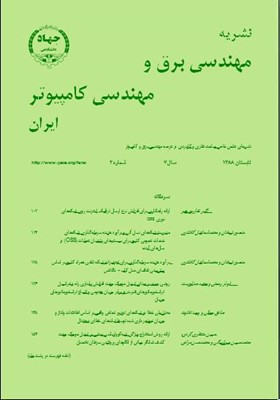کنترل یک فیلتر فعال به روش مستقیم توان با فرکانس سوئیچینگ ثابت
محورهای موضوعی : مهندسی برق و کامپیوتر
1 - دانشگاه صنعتی شیراز
کلید واژه: فيلتر فعالDPCكيفيت توانهارمونيككنترل مستقيم توان,
چکیده مقاله :
فيلترهاي فعال براي از بين بردن جريانهاي هارمونيكي و همچنين جبرانسازي توان راكتيو ناشي از بارهاي نامتقارن متصل به شبكه يا ولتاژهاي نامتقارن شبكه مؤثر ميباشند. در اين مقاله روش مؤثر و جديدي براي كنترل فيلترهاي فعال ارائه ميگردد. اين روش بر پايه كنترل مستقيم توان (DPC) با مدولاسيون بردار فضایي بنا شده است. همچنين بهجاي سنسورهاي ولتاژ خط از تخمينزن شار بهمنظور تخمين ولتاژ شبكه استفاده شده است. براي اين كه اين روش در برابر اعوجاجهاي بهوجود آمده در ولتاژ خط مقاوم باشد، از يك حلقه قفل فاز مؤثر و كارآمد به نام SDRF-PLL استفاده ميشود. مزاياي اين روش الگوريتم ساده، ديناميك مناسب، فركانس سوييچينگ ثابت و مقاومبودن روش كنترل در برابر اعوجاج خط ميباشد. صحت اين روش با استفاده از نرمافزار MATLAB تأييد شده است. شبيهسازيها نشان ميدهد كه اين فيلتر براي حذف توان راكتيو تزريقي از طرف بارهاي غير خطي و منابع نامتعادل مناسب ميباشد.
Active filters are effective for eliminating harmonic currents and improving reactive power due to nonlinear loads and unbalanced sources. In this paper an effective and new method for Control of active filter is investigated. Direct Power Control (DPC) with space vector modulation is employed for this control scheme. Also, the AC line voltage sensors with a virtual flux (VF) estimator are replaced. The control system is resistant to the majority of line voltage disturbances using by the idea of virtual flux and synchronous double reference frame phase-locked loop (SDRF-PLL) approach. Superior advantages of this method are simple algorithm, good dynamic response, constant switching frequency and resistant to the majority of line voltage disturbances. The operation of proposed control strategy is verified in SIMULINK/MATLAB simulation environment. The simulations show that this active filter is effective for eliminating reactive power injected from nonlinear loads and unbalanced sources. (NF) of low noise amplifier (LNA) are compared with each other.
[1] T. Noguchi, H. Tomiki, S. Kondo, and I. Takahashi, "Direct power control of PWM converter without power-source voltage sensors," IEEE Trans. Ind. Applicat., vol. 34, no. 3, pp. 473-479, May/Jun. 1998.
[2] F. Z. Peng, G. W. Ott, and D. J. Adams, "Harmonic and reactive power compensation based on the generalized instantaneous reactive theory for three - phase four - wire systems," IEEE Trans. Power Elec., vol. 13, no. 6, pp. 1174-1181, Nov. 1998.
[3] B. H. Kwon and J. H. Lim, "A line-voltage-sensorless synchronous rectifier," IEEE Trans. Ind. Applicat., vol. 14, no. 5, pp. 966-972, Sep. 1999.
[4] M. Malinowski, Sensorless Control Strategies for Three - Phase PWM Rectifiers, Ph. D. Dissertation, Inst. Control Ind. Electron., Warsaw Univ. Technol., Warsaw, Poland, 2001.
[5] S. Chen and G. Joos, "Direct power control of active filters for voltage flicker mitigation," in Proc. Ind. Appl. Conf., 36th IAS Annual Meeting, vol. 4, pp. 2683-2690, Sep./Oct. 2001.
[6] P. Rodriguez, J. Bergas, and L. Sainz, "New PLL approach considering unbalanced line voltage condition," in Proc. IEEE Int. Conf. Power and Energy Systems, pp. 329-334, Jun. 2002.
[7] ع. رحمتي، س. ا. ابريشميفر و ا. عبيري جهرمي، "كنترل مستقيم توان اكتيو و راكتيو با مدولاسيون بردار فضايي در يك اينورتر متصل به شبكه و توربين بادي،" چهاردهمين كنفرانس مهندسي برق، صص. 6-1، ارديبهشت 1385.

